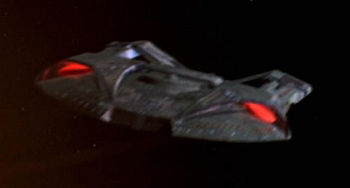Difference between revisions of "Steamrunner class"
m |
|||
| Line 80: | Line 80: | ||
<ref name="Decipher3">"[[Starfleet Operations Manual (Decipher #3)|Starfleet Operations Manual]]." ''[[Star Trek Roleplaying Game (Decipher)|Star Trek Roleplaying Game]],'' Book 3. Game. 2003. Decipher, Inc.</ref> | <ref name="Decipher3">"[[Starfleet Operations Manual (Decipher #3)|Starfleet Operations Manual]]." ''[[Star Trek Roleplaying Game (Decipher)|Star Trek Roleplaying Game]],'' Book 3. Game. 2003. Decipher, Inc.</ref> | ||
</references> | </references> | ||
| + | |||
| + | [[Category:Library]] | ||
| + | [[Category:Ships & Vehicles]] | ||
| + | [[Category:TNG]] | ||
| + | [[Category:DS9]] | ||
| + | [[Category:VOY]] | ||
| + | [[Category:STO]] | ||
| + | [[Category:Film]] | ||
| + | [[Category:Books]] | ||
| + | [[Category:Comics]] | ||
| + | [[Category:Game]] | ||
Revision as of 04:13, 28 August 2014

| Date Entered Service | 2369 |
| Length | 375m |
| Width | 270.9m[3] |
| Height | 78.5m[3] |
| Decks | 18 |
| Transporters (Personnel) | 4 |
| Transporters (Emergency) | 4 |
| Transporters (Cargo) | 4 |
| Shuttlecraft | 8[3] |
| Crew | 200 |
| Passengers | 250 |
| Evacuation Limit | 750 |
| Cruising Speed | Warp 6 |
| Maximum Safe Speed | Warp 9.2 |
| Emergency Speed | Warp 9.7 for 12 hours |
| Weapons | 4[3] Type X Phaser arrays[2] |
| 2 torpedo launchers;[2] 250[2] Type V[3] Photon torpedoes[2] |
The second class authorized by Starfleet's Perimeter Defense Directive (PDD), the Steamrunner class of heavy frigates borrowed numerous design specifications from its larger Akira class cousins. Quick and maneuverable, Steamrunner class vessels served with distinction in every Federation conflict since the class was first commissioned in 2369.[2][3]
Designed for a fairly specific group of mission profiles, the Steamrunner class also borrowed heavily from technologies developed for the Defiant Project, including a less vulnerable nacelle configuration, ship components that could be jettisoned during battle, a reduced area of active sensor coverage, and, as with all larger PDD classes, multilayer ablative hull armoring. Coupled with the already formidable armaments of the class, these advances contributed to the conventional wisdom that the various ship classes authorized by the PDD represented the next wave of starship design and construction.[2][3]
Steamrunner class vessels
- U.S.S. Appalachia
- U.S.S. Adirondack
- U.S.S. Circassia
- U.S.S. Enessi
- U.S.S. Great Smokey
- U.S.S. Khyber
- U.S.S. Matewan
- U.S.S. Shenandoah
- U.S.S. Steamrunner
- U.S.S. Sutter
- U.S.S. Tavda
- U.S.S. Tien Shan
- U.S.S. Wanderer
References
- ↑ Star Trek: First Contact. Film. 22 November 1996.
- ↑ 2.0 2.1 2.2 2.3 2.4 2.5 2.6 "The Price of Freedom: The United Federation of Planets Sourcebook." Star Trek: The Next Generation Roleplaying Game, Supplement 25100. Game. February 1999. Last Unicorn Games, Inc.
- ↑ 3.0 3.1 3.2 3.3 3.4 3.5 3.6 "Starfleet Operations Manual." Star Trek Roleplaying Game, Book 3. Game. 2003. Decipher, Inc.